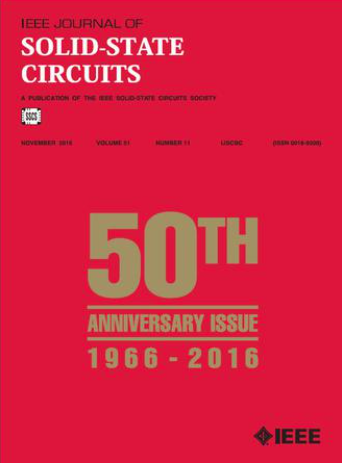一种利用集成晶体振荡器波形的低噪声数时转换器
IF 5.6
1区 工程技术
Q1 ENGINEERING, ELECTRICAL & ELECTRONIC
引用次数: 0
摘要
在本文中,我们提出了一种完全在晶体振荡器(XO)的正弦波形电压域中工作的数字-时间转换技术,然后将信号最终切片到可编程延迟时钟的时域。只需调整正弦信号的直流偏置即可获得精确的时序延迟。低复杂度的类正弦预失真使其传递函数线性化。该技术将数字时间转换器(DTC)的功能与XO生成相结合,从而大大降低了目标子系统的功耗,同时提供宽范围、高分辨率、低噪声和高线性度。由于不需要耗电的参考缓冲器/切片器,所提出的DTC从原始XO波形中获益,从而实现大延迟覆盖和高分辨率。XO+DTC的原型采用22纳米全耗尽绝缘体上硅(FD-SOI) CMOS制造,功耗仅为0.52mW,可实现546 ps的范围和266 fs的精细分辨率。在100mhz的输出频率下,它的有效值抖动(从1khz集成到10mhz)仅为86.6 fs。仅对预存储的正弦查找表(LUT)的基谐波进行预失真,测量的积分非线性(INL)降低到+2/−1.9 ps。再加上更高的谐波含量,如第二次到第四次谐波,峰值间的INL和DNL降至±1 LSB(即266 fs)以内。基于dtc辅助全数字锁相环(ADPLL)的系统建模,模拟的带内分数杂散(IBFS)可低至- 66 dBc。本文章由计算机程序翻译,如有差异,请以英文原文为准。
A Low-Noise Digital-to-Time Converter Exploiting Waveform of Integrated Crystal Oscillator
In this article, we propose a digital-to-time conversion technique operating entirely in the sinusoidal waveform voltage domain of a crystal oscillator (XO) before the signal’s final slicing into the time domain of a programmably delayed clock. Precise timing delay is obtained simply by adjusting the dc offset of the sine signal. A low-complexity sinusoidal-like predistortion linearizes its transfer function. The technique merges the functionality of a digital-to-time converter (DTC) with an XO generation, thus drastically reducing the power consumption of the targeted subsystem while offering a wide range with fine resolution, low noise, and high linearity. Without the requirement for a power-hungry reference buffer/slicer, the proposed DTC benefits from the raw XO waveform, resulting in a large delay coverage and fine resolution. Fabricated in 22-nm fully depleted silicon-on-insulator (FD-SOI) CMOS, the prototype of XO+DTC consumes only 0.52mW while achieving a 546-ps range with a fine resolution of 266 fs. Its rms jitter (integrated from 1 kHz to 10 MHz) is only 86.6 fs at the output frequency of 100 MHz. Using predistortion of only the fundamental harmonic of a prestored sinusoidal lookup table (LUT), the measured integral nonlinearity (INL) is reduced to +2/−1.9 ps. Together with a higher-harmonic content, such as the second to fourth harmonics, the peak-to-peak INL and DNL is brought down to within ±1 LSB (i.e., 266 fs). Based on system modeling of a DTC-assisted all-digital phase-locked loop (ADPLL), the simulated in-band fractional spur (IBFS) can be as low as −66 dBc.
求助全文
通过发布文献求助,成功后即可免费获取论文全文。
去求助
来源期刊

IEEE Journal of Solid-state Circuits
工程技术-工程:电子与电气
CiteScore
11.00
自引率
20.40%
发文量
351
审稿时长
3-6 weeks
期刊介绍:
The IEEE Journal of Solid-State Circuits publishes papers each month in the broad area of solid-state circuits with particular emphasis on transistor-level design of integrated circuits. It also provides coverage of topics such as circuits modeling, technology, systems design, layout, and testing that relate directly to IC design. Integrated circuits and VLSI are of principal interest; material related to discrete circuit design is seldom published. Experimental verification is strongly encouraged.
 求助内容:
求助内容: 应助结果提醒方式:
应助结果提醒方式:


